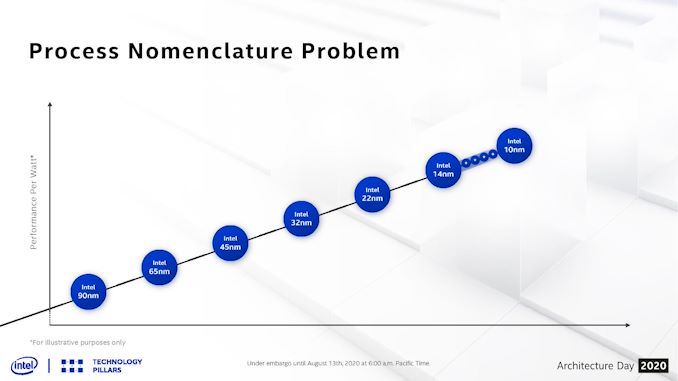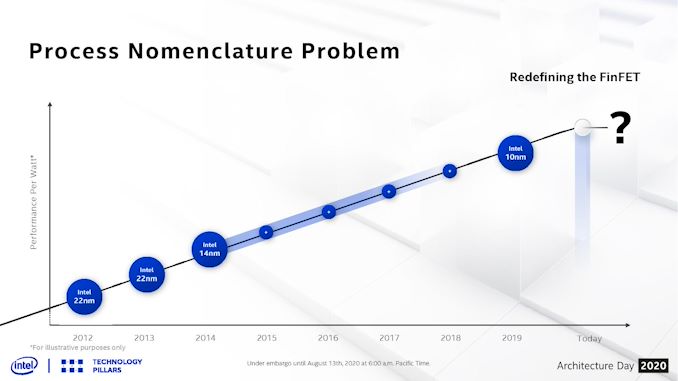What Products Use Intel 10nm? SuperFin and 10++ Demystified
by Dr. Ian Cutress on September 25, 2020 9:00 AM EST_678x452.jpg)
For our audience that regularly keeps track of Intel’s product portfolio, it would be hard to miss that the naming strategy of Intel’s process node technologies is a bit of a mess. To some, those words are themselves an understatement, as Intel has shifted its naming strategy 2-3 times since the launch of Intel’s first 10nm products. Not only that, even Intel’s various departments internally have a hard time keeping track of ‘what is this manufacturing process being called today’ when the press like AnandTech ask for details on the latest upcoming products.
Knowing this, and knowing what issues Intel has been having, I wanted to demystify Intel’s manufacturing process naming scheme such that users and engineers alike, even if they are inside Intel, can understand what is what but also importantly why. The why is the crucial factor.
If you're looking for a handy decoder ring for Intel's 10nm Products, it's here in page 3.
Why Do We Have Multiple Versions of a Process?
With Intel’s 14nm, we were invited to 14nm, 14+, 14++, 14+++, and if you believe Intel’s own slides, there were variants that went beyond this ++++ naming scheme. Each one of those additional + points on the end of the name signified a change in the process technology – usually to assist for increasing performance or efficiency.
Each one of these + points is an update to the BKM, or Best Known Methods.
While an engineer can draw an electrical layouts for a part of a processor, such as an addition circuit, actually applying that design to a silicon floorplan for manufacturing is a different skill altogether. Transistor libraries are designed to take advantage of a given process, and when a floorplan is optimized for a process, it can then be pasted and repeated as necessary – on top of this, simulation on thermals, power, and current density are applied to ensure that there are no hotspots or that critical paths inside the design have as few bottlenecks as possible.
When an update to the BKM occurs, two things can happen. Normally we see the update on the level of the transistor library that is changed – if the distance between two fins on a transistor increases for example, the transistor library and the macros may be made bigger, and then the floorplan might be redesigned to take account for this. As for any process node design, there are 100 different controls, and improving one might make three other controls worse, so it is a fine balancing act. Not only this, but the BKM has to be validated at the manufacturing level. The BKM update could apply to the metal stack as well, which in of itself can adjust the performance.
In the long long past, BKM updates were never advertised externally. If Intel or TSMC or another foundry discovered a way to improve the performance, or decrease the voltage, or improve the yield, the update was silently rolled into the design and nothing much was made of it. Sometimes processors would be listed as ‘1.0 volts to 1.35 volts’, and it would just be a roll of the dice if a user obtained one of the lower voltage models.
However, as time between different process node updates has elongated, these BKM updates have started to be identified and effectively monetized by the semiconductor companies. An update to a process that improves the voltage by 50 millivolts and increases frequency by 200 MHz immediately becomes a productizable event, and products built on these updates can be offered for more money over the usual. Or, depending on the rate of updates, the whole next generation of products could be built on the update.
So we never saw BKM updates officially announced at Intel’s 45nm, 32nm, or 22nm process nodes. These updates were fast enough that the productization of any update didn’t warrant a full round of marketing. With 14nm, that changed.
Intel had discussed its roadmap beyond 14nm since its 2010 Investor Meeting. It predicted that the company would be on 14nm by 2013, 10nm by 2015, and 7nm by 2017. As we now know, 14nm was two years late, and 10nm was 2-4 years late. Because of the introduction of 10nm being delayed, Intel decided to productize its 14nm BKM updates, and signified those with + points.
Intel’s current official line is that there have been four updates to 14nm, creating five ‘generations’.
More Plus Means More Meme
Because of all the + points, Intel’s marketing sometimes getting it wrong, and perhaps a little bit of ‘++’ in most programming languages meaning ‘+1’, the whole concept of adding + to the process node has become a meme – a meme at Intel’s expense, purely on the basis of its failure to deliver 10nm before the 14++++ naming scheme got out of hand.














143 Comments
View All Comments
Spunjji - Monday, September 28, 2020 - link
Holy crap, is AMDSuperFan TheJian's sockpuppet? They both make almost exactly as little sense as each other, and I can't imagine why anyone else would bother replying seriously 😂TheJian - Tuesday, September 29, 2020 - link
So you just don't understand stocks or how to run a business...No comments on my data then..OK. Thanks for confirming my point, since you clearly can't debate it.As for commenting on his post. He likes to play consoles. So what does that do for AMD income? You two both don't get it.
https://www.macrotrends.net/stocks/charts/AMD/amd/...
https://www.macrotrends.net/stocks/charts/AMD/amd/...
16 years of data, pull those up and have a stock chart of the last decade up on another monitor and you should get the point...If you don't get what I said, you're not too bright. It was simple talk. Easy math. Learn to debate:
https://islamreigns.files.wordpress.com/2019/01/pa...
It's comic where the link leads...But some can't use svg's which are everywhere else it seems. They're talking about YOU being at the bottom. Name calling. L1. Nice work. I'd block you, but anandtech is not smart enough to allow a checkbox for it ;)
Teckk - Sunday, September 27, 2020 - link
So you're not a console fan companies are supposed to stop making them? Ok.You're a proud Intel shareholder hmmm how much has the stock grown in the last 8 years?
If you're buying Intel stocks just because you support or like Intel, I hope you don't give or no one follows your stock advice.
Qasar - Sunday, September 27, 2020 - link
na, that's just the Jian's usual pro intel, rant.TheJian - Wednesday, September 30, 2020 - link
What is pro Intel about telling AMD to start making money by raising prices? I spent most of the post explaining why they should stop making crap that has no profits and move to stuff that will make them rich. What part of that do you not get? I am practically begging them to make money so they and have more R&D, win, etc. The fact that I own Intel is just simple math. You are DUMB if you own AMD at this price, or just simply haven't even done some quick math.https://islamreigns.files.wordpress.com/2019/01/pa...
Learn to debate. You said nothing and worse, failed to understand the content of my post. Comic where that jpg is...SVG's of it are everywhere, but jpg a little tougher to find. You failed.
TheJian - Wednesday, September 30, 2020 - link
AMD isn't making enough on them, that is the point. If short on silicon make the highest margin stuff right? It's that simple. Ask Intel.Don't care what they made in 8yrs. I've only owned then since the drop to 43 while still making the same income as a few weeks before at 70. I don't like ANY company; I like the money they make me though. Does that count? I BUY hardware from the winner, period, for what I need done most. I have all 3 in my PC's (Intel, AMD, and Nvidia...ROFL). I was an AMD reseller for 8yrs. I like the company, just hate the management. Lisa Su made 59mil last year, most of any CEO in S&P500 on earth. Her company made 660m, less than all others on the top ten list who make BILLIONS of NET INCOME. Intel made 23.6B NET INCOME, but last year Intel CEO made 66mil (on 23.6B!).
My points are about money here, which you don't seem to have a concept of, so I don't expect you to get the message. Move along. I've never been proud to own a stock (name means nothing). They're just things to make profit on. I didn't own Intel since $26 or so ages ago (~2006-2007, sold never came back until now). That said, if you're talking last 8yrs. Ok.
Sept 2012 $22, today, $50. Not bad money, but if you sold recently you could have had $70. Very good money now for most. But with a price of ~45, I like my chances of $100 by Q1 2022 or before. I'll leave early of course. I was explaining why to buy or not buy stuff you just weren't listening. I gave links to 16 years of data. You can't read? It had nothing to do with being a FAN of company X, it was all about WHY AMD isn't (or IS in NV/Intel cases) making money that they should be based on the price of the stock, share of the market etc. This is stock advice. I don't see you debating any of it either. I see you making a fool of yourself.
But yeah, not a fan of what consoles are doing to AMD's NET INCOME and R&D, they should have passed like NV for the same reason as NV (robs from core R&D and no margin). Any silicon spent on a single digit to mid teens margin product (AMD said it) is WASTED and should be spent on higher end stuff for NET INCOME and REAL margins! See what Intel did. Short on silicon, they moved production to servers and HEDT. Screw celeron/poor people, not the rich. Without the rich to pay the bills you can't afford to support the poor ;) See 1/2 the country that doesn't pay a dime in taxes (is that a fair share?? LOL). I buy stocks so I don't have to care who makes my chip or what price it is, because it is FREE to me via the stock income. NV/AMD bought all my chips for years to come, though Intel will be buying next years probably (or MU as DDR5 etc kicks off and buy cycle with it, many others just do the homework)...ROFL
Teckk - Wednesday, September 30, 2020 - link
If you'r as objective as you claim to be, why do you care about the management of AMD? Why does it matter what the CEO's pay is to you?You buy hardware from a winner? Why not buy the best performant hardware that you need? Again, why does it matter what brand it is then?
You're telling AMD might hit $30 soon or 100? Or is $100 the target for Intel in 2022?
Console margins are 15+% from 2015 onwards. You seem to be pretty good with the links, surprised you missed this one. Definitely not the same as Ryzen, but you don't abandon a market overnight. And if you're the ONLY player you can charge more for it. Zen2 in PS5 and Xbox will not be sold at cost or at a minimal margin too, I'm sure you know.
Intel still makes Celereons and dual core stuff and Wi-Fi cards and more, maybe you should tell them to move that onto higher margin stuff like server processors.
Everett F Sargent - Sunday, September 27, 2020 - link
That was much worse than the Unabomber's manifesto! You need to move out of that yurt way up there in Mongolia.Spunjji - Monday, September 28, 2020 - link
I love the idea that Nvidia isn't in consoles because they said "ROFL. Whatever dude", even though, you know, Nvidia is in the Switch - that most premium of consoles... and they tried selling their own console (the Shield) several times over... and the only reason they aren't doing business with Sony since the PS3 is because AMD could offer the full CPU/GPU package... and the only reason they aren't in the Xbox is because they tried to rip Microsoft off back with the OG Xbox.But sure, it's because they're too cool for consoles (that they're still involved with). Seems legit. 😏
Beaver M. - Tuesday, September 29, 2020 - link
What do you mean *tried* to sell their own console?The Shield is very successful.